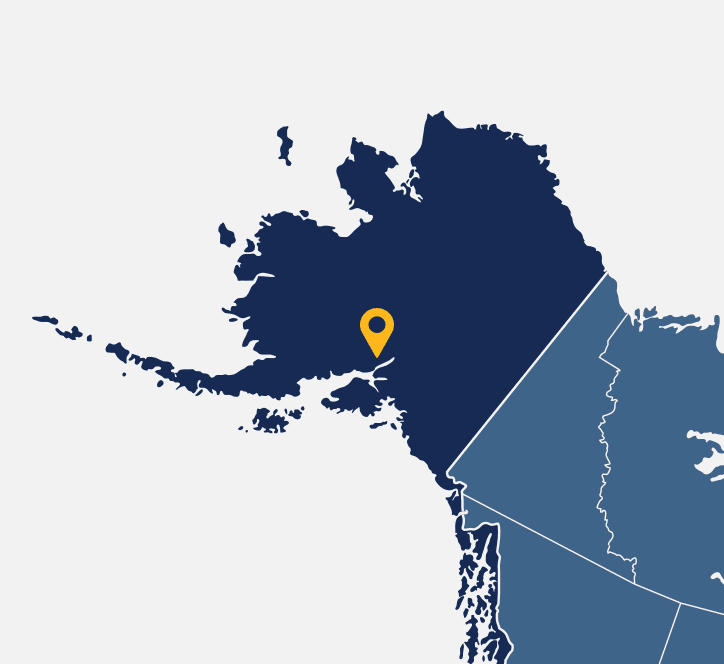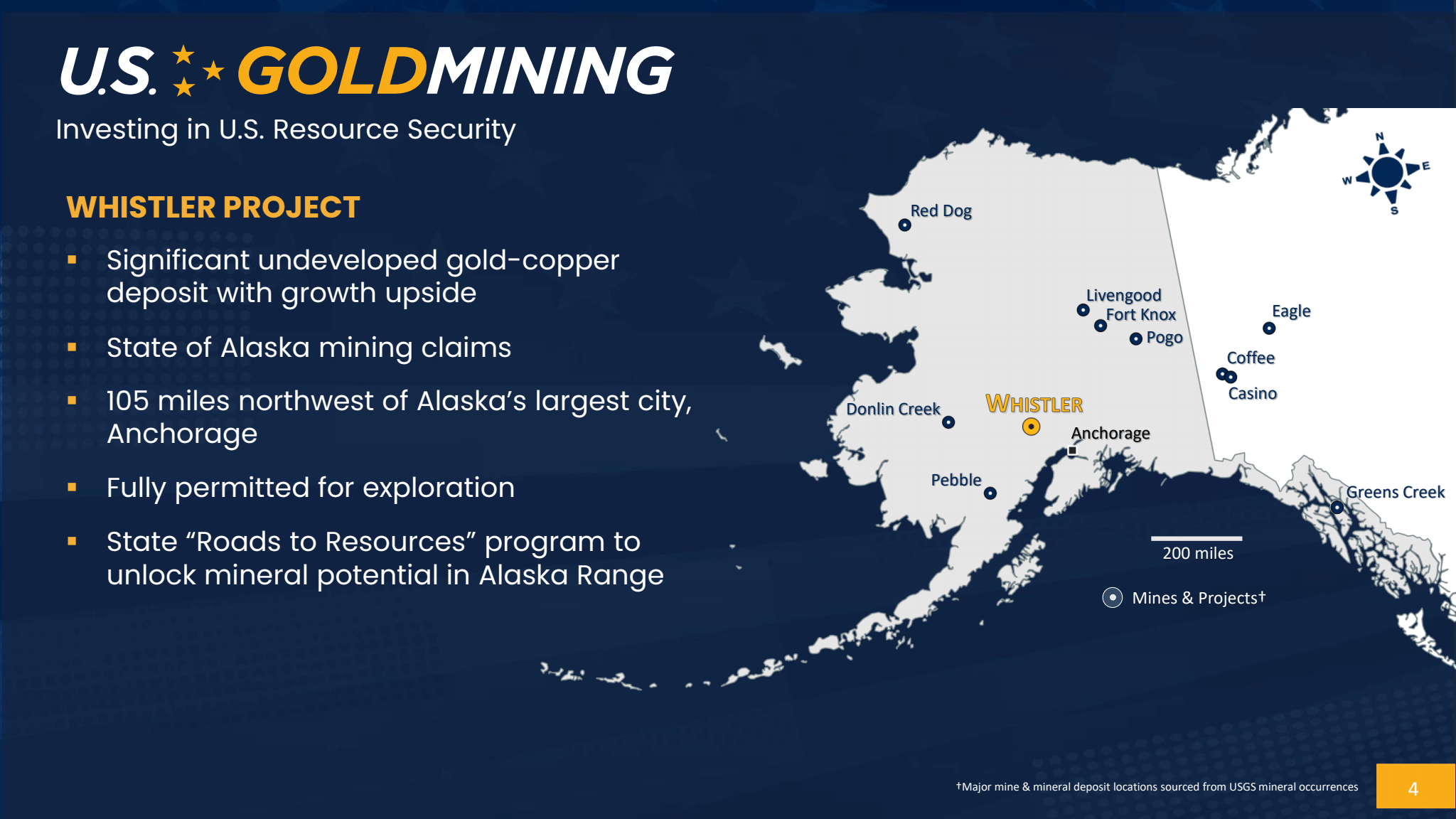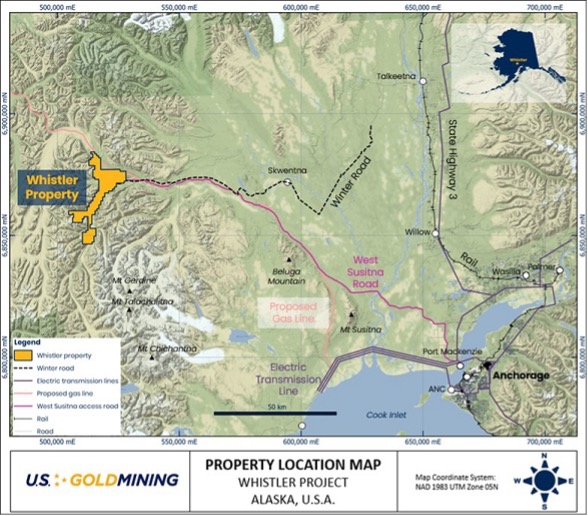Project Snapshot
Overview
Whistler is a resource stage gold-rich copper porphyry exploration project located within the Alaska Range 105 miles (170 km) northwest of Anchorage, Alaska, USA. The regional land package comprising State of Alaska mining claims totals 53,700 acres (217 sq km).
The Whistler Project has indicated resources of 6.5 million gold equivalent ounces and inferred resources of 4.2 million gold equivalent ounces. Mineral resources have been estimated at three gold-copper porphyry deposits (Whistler, Raintree West and Island Mountain) and several additional geophysical and geochemical targets anomalies contain mineralized drill intersections that require follow-up drilling.
The Whistler Gold-Copper Project is supported by an existing base camp and gravel airstrip which are established for quick startup of field programs.
Whistler’s growth potential includes opportunity for U.S. GoldMining’s technical team to apply new regional geologic models to unlock value for Whistler, as well as following best practices in safety, environment and sustainability to optimize project advancement towards eventual future potential permitting and mine development.
Location
105 miles northwest of Anchorage, Alaska, USA
Property Size
53,700 acres (217 sq km)
Ownership
100%
Commodity
Gold, Copper
Infrastructure
Airstrip, camp, drill trails access Whistler and Raintree deposits; seasonal winter road.
Deposit Type
Gold-rich copper porphyry

Technical Reports
Location
The Whistler Project is located in the Alaska Range approximately 105 miles (170km) northwest of Anchorage. The centre of the property is located at 152.57 degrees longitude west and 61.98 degrees latitude north.
The Whistler Project comprises 304 State of Alaska mining claims covering an aggregate area of approximately 53,700 acre (217km2) in the Yentna Mining District of Alaska. The claims are 100% owned by U.S. GoldMining.
An all season camp facility exists near the confluence of Portage Creek and the Skwentna River, approximately 15km southeast of the Rainy Pass Hunting Lodge. The camp is serviced with a 1,000m gravel airstrip for wheel-based aircrafts. The camp is equipped with diesel generators, a satellite communication link, tent structures on wooden floors, and several wood-framed buildings.
An all season camp facility exists near the confluence of Portage Creek and the Skwentna Riveradjacent to the Whisky Bravo 1,000m gravel airstrip
West Susitna Road
Exploration and mining in the Alaska Range is receiving strong local support at the community, regulator and state political level. The State Government, via the Alaska Industrial Development & Export Authority (‘AIDEA’) has initiated a ‘Roads to Resources’ program to design, permit and build the West Susitna Road which will link to the Whistler Project.
From Anchorage, Whistler is located 105 miles northwest across the Yentna – Susitna River Valley, a broad alluvial plain. Whistler is located just inside the Alaska Range, in the foothills. A road to access this area is a relatively simple matter in terms of engineering and with the State leading this work at present, ultimately the Company expects an efficient permitting process and ultimately a shared capital cost of the access road construction.
AIDEA’s brief is to study, optimize and build infrastructure projects that will deliver growth to the Alaskan economy. AIDEA has completed three major studies on the West Suistna Access Road since 2014, to assess route alternatives, cost and benefits, and environmental and cultural impacts of building a road that will provide access to various resources and also recreational access to the public.
In 2022 $8.5M was budgeted for preliminary design, environmental baseline and stakeholder consultation. Recently (AIDEA press release March 21, 2023) AIDEA announced that construction could potentially begin as early as 2025, pending approvals and financial investment decisions. A further key advantage which the West Susitna Road will provide to the Whistler Project, is the already constructed but underutilized port facility at Port Mackenzie which lies at the eastern terminus of the proposed road.
Via press release on March 21, 2023, Governor Mike Dunleavy said, “The West Susitna Road is important for local residents and gaining fair access to hunting, fishing, and potential jobs. My Administration is constantly looking at ways to grow our economy and this project is a great opportunity for not only south-central Alaska but the entire state. I am committed to this project and unlocking resources that benefit all Alaskans.”
Geologic Setting and Mineralization
Alaskan geology consists of a collage of various terrains that were accreted to the western margin of North America as a result of complex tectonic plate interactions through most of the Phanerozoic. The southernmost Pacific margin is underlain by the Chugach–Prince William composite terrain, a Mesozoic-Cenozoic accretionary prism developed seaward from the Wrangellia composite terrain. It comprises volcanic arc batholiths and associated volcanic rocks of Jurassic, Cretaceous and early Tertiary age.
The Alaska Range represents a long-lived continental arc characterized by multiple magmatic events ranging in age from about 70 million years ago ("Ma") to 30Ma and associated with a wide range of base and precious metals hydrothermal sulphide bearing mineralization.
The geology of Whistler Project is characterized by a thick succession of Cretaceous to early Tertiary (ca. 97 to 65 Ma) volcano sedimentary rocks intruded by a diverse suite of plutonic rocks of Jurassic to mid-Tertiary age.
Two main intrusive suites are important in the Whistler Project area:
- The Whistler Igneous Suite comprises alkali-calcic basalt-andesite, diorite and monzonite intrusive rocks dated to approximately 76Ma, with minor extrusive volcanic equivalent rocks. The intrusions are commonly associated with gold-copper porphyry-style mineralization (e.g. Whistler Deposit).
- The Composite Suite intrusions vary in composition from peridotite to granite and their ages span from 67 to about 64Ma. Gold-copper veinlets and pegmatitic occurrences are characteristics of the Composite plutons (e.g. Estelle deposit (Nova Minerals) and the Muddy Creek prospect).
Early exploration work completed by Cominco, Kennecott, Geoinformatics and Kiska has discovered several gold-copper porphyry-style sulphide occurrences. The Whistler property contains numerous geophysical and geochemical anomalies suggesting that the project area is generally highly prospective for magmatic hydrothermal mineralization including potential for additional porphyry gold-copper deposits.
Current Activities:
- Historic drilling completed: 257 holes (70,247 m)
- Established resource includes gold (1.94 Moz gold Indicated & 4.7 Moz gold Inferred) and copper (422 Mlbs copper indicated & 711.4 Mlbs inferred) - See Resource Statement
- Database validation and creation of GIS and 3D data sets
- Geologic interpretation at deposit and mineral system scale
- Geophysical modelling and interpretation
Resource Statement
Notes to Table 1:
- Mineral resources are not mineral reserves and do not have demonstrated economic viability. There is no certainty that all or any part of the mineral resources will be converted into mineral reserves.
- Inferred mineral resources are subject to uncertainty as to their existence and as to their economic and legal feasibility. The level of geological uncertainty associated with an inferred mineral resource is too high to apply relevant technical and economic factors likely to influence the prospects of economic extraction in a manner useful for evaluation of economic viability.
- The Mineral Resource Estimate for the Whistler, Island Mountain, and the upper portions of the Raintree West deposits have been confined by an open pit with “reasonable prospects of economic extraction” using the following assumptions:
- Metal prices of US$1,850/oz Au, US$4.00/lb Cu and US$23/oz Ag;
- Payable metal of 95% payable for Au and Ag, and 96.5% payable for Cu
- Refining costs for Au of US$8.00/oz, for Ag of US$0.60/oz and for Cu of US$0.05/lb.
- Offsite costs for Au of US$77.50/wmt, for Ag of US$3.50/wmt and for Cu of US$55.00/wmt.
- Royalty of 3% NSR;
- Pit slopes are 50 degrees;
- Mining cost of US$2.25/t for waste and mineralized material; and
- Processing, general and administrative costs of US$7.90/t.
- The lower portion of the Raintree West deposit has been constrained by a mineable shape with “reasonable prospects of eventual economic extraction” using a US$25.00/t cut-off.
- Metallurgical recoveries are: 70% for Au, 83% for Cu, and 65% Ag for Ag grades below 10g/t. The Ag recovery is 0% for values above 10g/t for all deposits.
- The NSR equations are: below 10g/t Ag: NSR (US$/t)=(100%-3%)*((Au*70%*US$54.646/t) + (Cu*83%*US$3.702*2204.62 + Ag*65%*US$0.664)), and above 10g/t Ag: NSR (US$/t)=(100%-3%)*((Au*70%*US$56.646g/t) + (Cu*83%*US$3.702*2204.62))
- The Au Equivalent equations are: below 10g/t Ag: AuEq=Au + Cu*1.771 +0.0113Ag, and above 10g/t Ag: AuEq=Au + Cu*1.771
- The specific gravity for each deposit and domain ranges from 2.76 to 2.91 for Island Mountain, 2.60 to 2.72 for Whistler with an average value of 2.80 for Raintree West.
- The SEC definitions for Mineral Resources in S-K 1300 were used for Mineral Resource classification which are consistent with Canadian Institute of Mining, Metallurgy and Petroleum (CIM) Definition Standards for Mineral Resources and Mineral Reserves (CIM (2014) definitions).
- Numbers may not add due to rounding.
Additional details of the mineral resource estimate are set forth in the S-K 1300 Report titled “S-K 1300 Technical Report Summary Initial Assessment for the Whistler Project”, Effective Date 12 September 2024 and Date of Issue 7 October 2024, a copy of which is available under the Company's profile at www.sec.gov.











